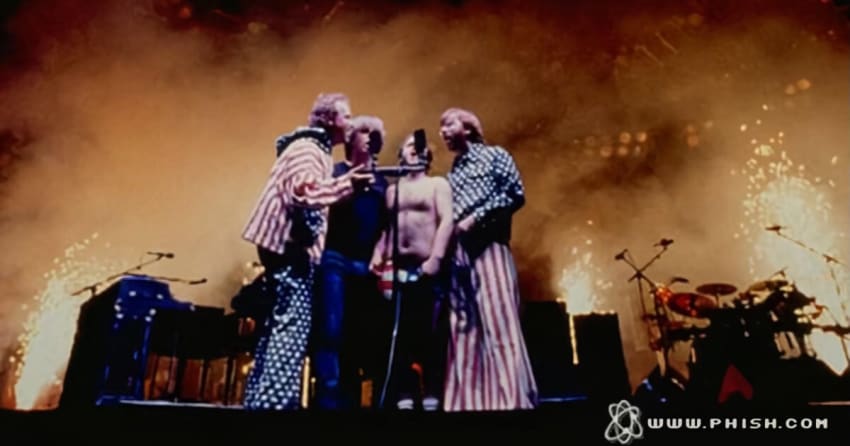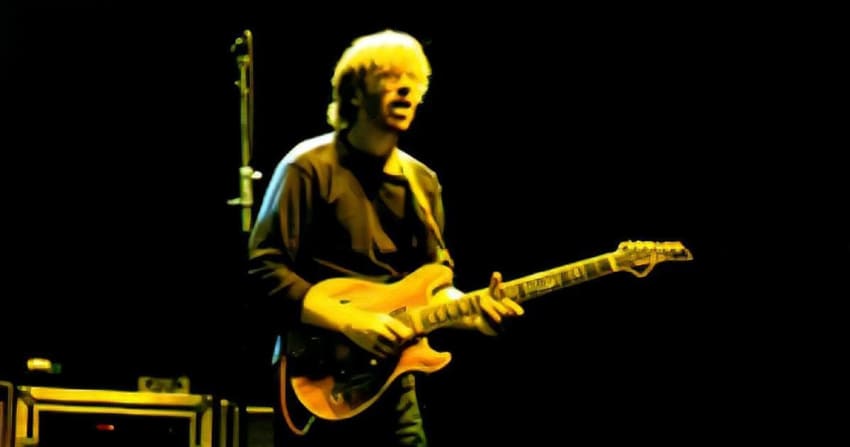Revisiting Phish’s Transformative 1999, 25 Years Later
Rob Mitchum explores the key moments from 25 years ago during one of the band’s most transitionally important period.
By Rob Mitchum Dec 24, 2024 • 8:20 am PST
Journalist Rob Mitchum is the author of Phish Essays, featuring essays about each show since 1993, posted in conjunction with the 25th anniversary. After reviewing Phish’s 1999 performances, Rob’s essay below looks back 25 years ago to assess the integral moments that occurred throughout one of most important years in the band’s career.
1999 was a weird year for all of us. Thanks to the arbitrary math of some sixth-century monk, it meant we were approaching a big fat round number, not just the end of a century but an entire millennium. Even the less superstitious had reason to believe that landmark would mean something, be it the global collapse of computerized networks or the dawn of a new era of world peace and flying cars. Whatever the expectations, it created a fog of uncertainty that had people feeling and acting wild.
For those of us in the college-age demographic, the logical reaction was to hit the road and see Phish as many times as possible. I saw 14 shows that year, doing my longest-ever tour run in the summer and trekking down to Big Cypress, with some fall/winter shows sprinkled in between.
All that attendance bias locked in 1999 as one of my favorite years of Phish, their last triumphant lap before a fraught 2000s. But it wasn’t until I revisited every show this year as part of my 25-year anniversary essay project that I realized what a strange year it was for Phish too.
Advertisement
In a decade full of constant evolution, it’s probably Phish’s most transitional year of all. And unlike the others, it marked changes both positive and negative. Phish’s last year of the millennium never lacked ambition, including onstage experiments with their most abstract music yet, new instruments and places to stand, a solo tour, and two festivals.
Brimming with confidence from the success of their 1997 reinvention, the band doubled down on taking risks. And for the first time, some of those gambles didn’t pay out.
Many of the seeds of Phish’s hiatus and eventual breakup were planted that year. But at the same time, the framework was established for the band’s astonishing longevity, the fruits of which we’re still miraculously enjoying today.
1999 was the end of Phish innocence and the sunrise of its modern form.
Spring: External Affairs
It’s apt that a fractured year began with two very significant events that didn’t even involve all four members of Phish. In April, the original jam band torch-pass went down in San Francisco, where Phil Lesh celebrated a successful liver transplant by inviting Phish keyboardist Page McConnell and guitarist Trey Anastasio to be his special Friends.
The three-show run – and the return leg when Phil joined Phish in September – proved to be more than just symbolic, with Trey battling Steve Kimock over Jerry’s legacy and Phish (well, half of them, at least) proving they had built up the clout to resist becoming just another Dead knock-off. The official succession ceremony may have been slow in coming, but the delay allowed Phish to establish their own path instead of just continuing the Dead’s.
But that path was also starting to splinter. In May, Trey played his first official solo tour, recruiting drummer Russ Lawton and bassist Tony Markellis for a dozen dates featuring new tunes and a streamlined sound. It was the first time since 1983 that Trey took a band that wasn’t Phish on the road, developing his latest wave of ideas in a group with different talents and a very different power structure.
At first, it wasn’t clear whether the would be a firewalled, separate project from Trey’s main gig. But as the year went on, more and more of its songs and sonics crossed over into Phish, eventually becoming the main influence on their 1999 sound despite originating from outside. It established a dynamic that continues to this day – TAB as incubator for Phish.
Listening Guide:
- April 16: Bertha (Phil & Friends)
- May 6: Ooh Child (TAB)
- May 14: Sand (TAB)
Summer: Texture and Temperature
But when Phish proper finally launched its year on the last day of June, the first big change was simultaneously routine and consequential. After sticking with the Nectar’s formation for well over a decade, Phish reshuffled its stage order, moving Trey to stage left and putting bassist Mike Gordon between Page and drummer Jon Fishman. It was more than just visually disorienting; with the bandleader standing on the wing, further separated from the rest of the band by his new synthesizer, the blocking reflected a musical shift away from the hard-won group democracy of 1997-98.
But that was less obvious on the Summer Tour, which “promoted” a very peculiar “new” “album.” The Siket Disc was released via phish.com in early June, containing nine tracks sculpted by Page from studio jams recorded way back in 1997 around the making of The Story of the Ghost. Though the music was two years old by the time it was released, its curation reflected improvisational priorities Phish had developed over the course of 1998 – more abstract, ambient, and focused on texture instead of melody and fireworks.
Exploring that sound in the large, boomy sheds of Summer Tour was a counterintuitive choice, but it led to fascinating sets in Charlotte and Mansfield where the band tinkered with what they would eventually refine into arena ambient.
“What’s the Use?” and “My Left Toe” pulled the band into a meditative state that often evades them in front of a large crowd hungry for the big, loud climax. But arriving at that reward through a different path could pay off hard – the Camden “Chalk Dust,” one of the most exhilarating jams Phish ever played, is built from some of the same atmospheric layering and hard-groove ingredients that would come to dominate the year.
After an Upstate New York semi-festival, the mood of the tour changed into something more chaotic under a midwestern heat wave. Trey screeching about the Helping Friendly Book and the similarities between “Cat Scratch Fever” and “Smoke On The Water” conjured a strange mood for the final week, which veered between immaculate and overserved, foreshadowing the troubling inconsistencies of Phish’s 2000s.
It concluded with another potent symbol of the century’s end – Phish somewhat obliviously patting themselves on the back in Noblesville while Woodstock 99 smoldered 900 miles away.
Listening Guide:
- July 8: Fee
- July 10: Chalk Dust Torture
- July 13: Wolfman’s Brother
- July 15: Split Open And Melt
- July 21: Simple > My Left Toe
Advertisement
Fall: Borrowed Tunes
Due to the year’s late start, the summer and fall legs were only separated by six weeks, with the band’s first trip to Japan further reducing the time off. But the Phish that returned in September still sounded dramatically different than its summer mode, thanks largely to the infusion of songs debuted with TAB. The adaptation wasn’t seamless.
Songs like “Sand,” “First Tube” and “Gotta Jibboo” were written with and tailored to the steady, heavy-groove strengths of Lawton and Markelis, an approach vastly different from the preferences of Fish and Mike.
With those songs in heavy rotation and their style bleeding into jams on Phish classics as well, Fall Tour was an inconsistent month of shows, the most frustrating run since the water-treading year of 1996. Split between outdoor dates in warm-weather regions and more traditional autumn arenas, the band struggled to find its identity, caught between the lighter touch of the summer and the heavy sound they’d master in the winter.
They also had one eye on recording their next album, with studio time scheduled for the tour’s end that would kick off the production of Farmhouse, an LP that would inherit this tour’s indecisiveness.
But as always, there were still moments of brilliance. Trey’s 1999 sound is fetishized for a reason; his use of effects pedals, loops, and the occasional keyboard sample fully realizing a shoegaze wall of sound he’d assembled all decade. His output – which could often involve multiplying himself many times over – constantly threatened to overwhelm the rest of the band, further tipping the scales to stage left.
But when it worked, it worked: legendary nights in Boise, Chula Vista, and Memphis showcase his vision in its ideal form.
Listening Guide:
- September 12: Ghost
- September 22: AC/DC Bag
- September 29: 2001
- October 1: Bathtub Gin
- October 8: Tweezer
Winter: Long Distance
After another shorter-than-usual break, Phish speed-ran a circuit of shows in their traditional Eastern Time Zone stronghold. While it could have easily just been a warm-up session for Big Cypress, the December Tour also managed to tie together a lot of the year’s disparate threads into a cohesive and satisfying whole. Studio work made the band more comfortable playing the TAB material, with “Sand” in particular blooming into the month’s signature song.
The best jams of the tour welded the sound collages of Hot Siket Summer to the cosmic groove trances of fall, producing passages that were nuanced in detail but dynamic and driving enough to hold the attention of an arena crowd. It was a deliberative, post-rock approach well suited for Big Cypress when the band would need to play 14 hours of music in two days, and it produced a series of long, heavy jams that possibly work better at home and in soundboard versus in the room or via the taper’s section. That might explain the mixed opinions on this particular odd-year December, though I expect its reputation to grow with each official release.
That just left Big Cypress, the ultimate experiment in “Can You Have Too Much Phish?” The all-night set would test the mettle of band and crowd alike, producing a musical monolith that still remains difficult to grapple with critically. It always felt a bit weird that December 31, 1999 tops the phish.net ratings for greatest show ever, like it shouldn’t compete in the same category as a two-setter at Nassau or Hampton. But while Big Cypress feels like it exists outside of normal Phish time and space, it also could only have happened in 1999, a year when the band was brimming with creativity, patience, and most importantly, absolute gall.
The festival turned out to be a pyrrhic ending to Phish’s astonishing ‘90s, an act that the band found nearly impossible to follow. There was no apocalypse waiting at the stroke of midnight on January 1, 2000, but by the end of the year, Phish would be on hiatus, an inauspicious start to their most difficult decade.
You could blame the excesses of 1999 for setting up that downfall, but it was also inevitable – a band that had spent 10 years topping themselves again and again finally hit a wall they couldn’t leap. Phish had to find their breaking point before they could pull back to a sustainable long-term pace. And while it takes another quarter-century of perspective to realize it, the millennial mania of 1999 was that pivotal point.
Listening Guide:
- December 3: Limb by Limb
- December 7: Halley’s Comet
- December 11: Sneaking Sally > Ghost
- December 13: Sand
- December 30: Mike’s Song
- December 31: Crosseyed & Painless




